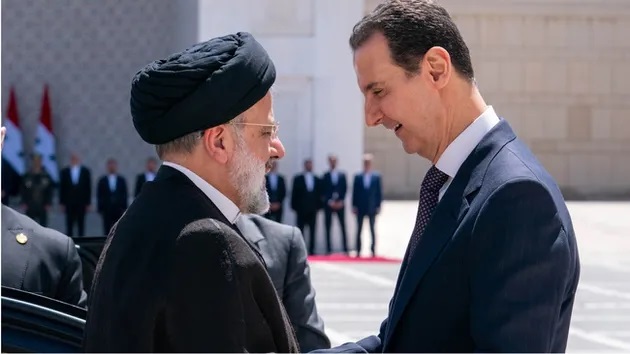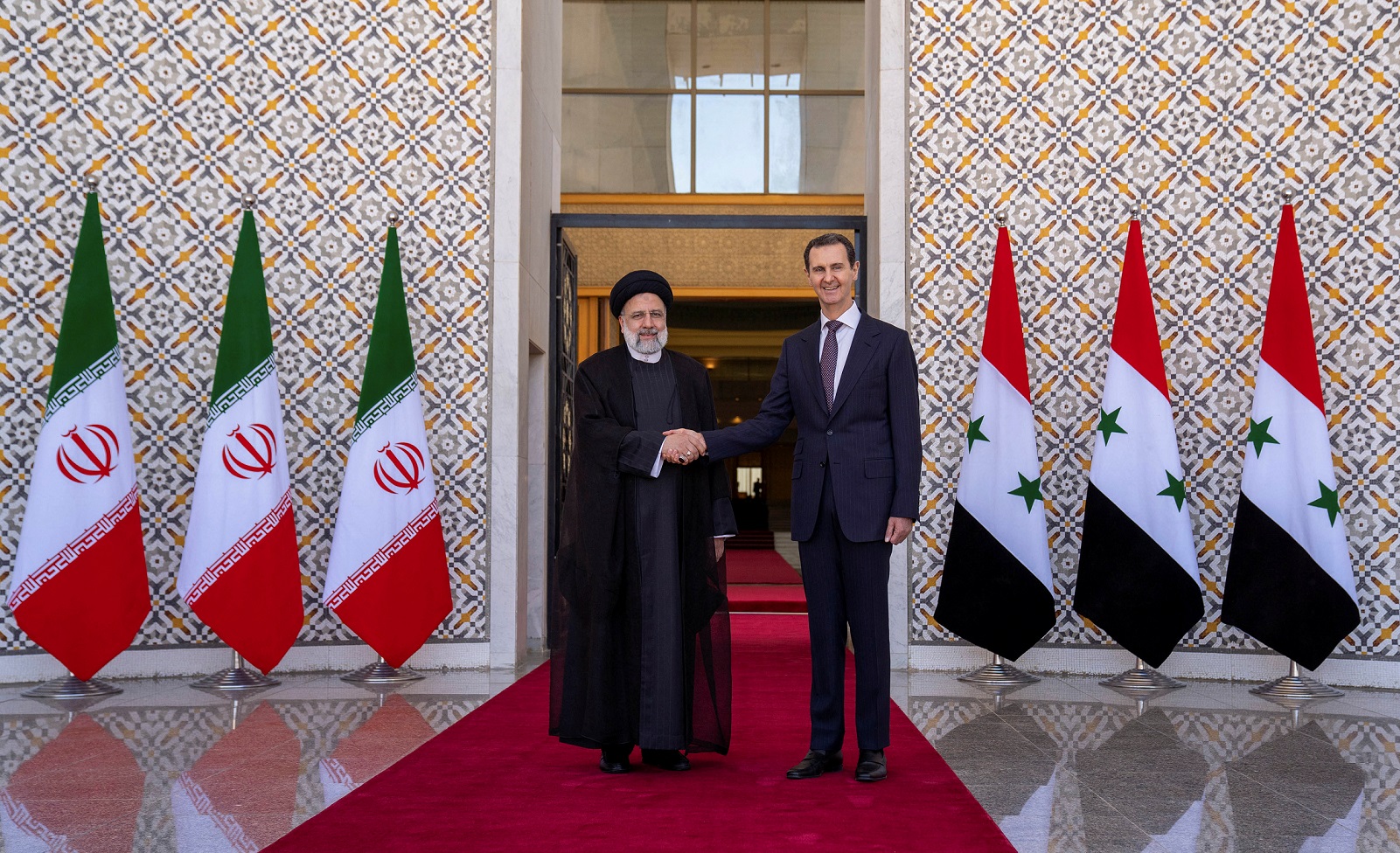Publications
INSS Insight No. 1725, May 16, 2023
The recent visit by Iranian President Ebrahim Raisi to Syria marked a significant achievement for Iran, as it was seen partly as a response to the normalization process between Israel and several Arab countries. The visit was presented by both countries as a demonstration of unity amidst a changing regional reality and a victory for the so-called axis of resistance. It took place against the backdrop of the improving relations between Iran and Syria and several Arab states, ongoing conflict between Israel and Iran on Syrian soil, and Iran’s efforts to enhance coordination among the various elements comprising the resistance axis. One focal point of the visit was Iran’s efforts to promote economic and commercial cooperation with Syria, which is vital for Tehran given its deteriorating economy. The strong alliance between these two strategic allies serves as additional evidence that current attempts to alienate the Assad regime from Iran are not viable. However, the real test for the success of the visit lies in Iran’s ability to achieve tangible gains, particularly in the economic sphere.
Iranian President Ebrahim Raisi paid an official visit to Syria on May 2-3, 2023, accompanied by a delegation of high-ranking officials, including the Ministers of Foreign Affairs, Defense, Oil, and Transportation. This visit marked the first time an Iranian President has visited Damascus since President Ahmadinejad’s visit in early 2010. Both Iran and Syria presented Raisi’s visit as a demonstration of unity amidst a changing regional reality and as a symbol of victory for the resistance front, led by Iran and Syria, after 12 years of Syria’s civil war. President Raisi’s associates described the visit as a sign of the strategic triumph for the Islamic Republic in the region and as a significant turning point at the regional level.
Indeed, Raisi’s visit to Syria took place amid several highly significant regional developments. First, there has been an improvement in ties between both Iran and Syria and several Arab states, first and foremost Saudi Arabia. In recent months, the Middle East has witnessed a flurry of new arrangements, such as the renewal of ties between Iran and Saudi Arabia, the anticipated restoration of diplomatic relations between Saudi Arabia and Syria, which were severed over a decade ago, and the decision to reinstate Syria’s membership in the Arab League, which was suspended following the outbreak of the civil war. Additionally, the rapprochement between Iran and Syria and several other Arab states, including the UAE, Jordan, and Egypt, has been ongoing. Iran perceived these processes as an opportunity to alleviate tensions within the Arab world and foster improved relations between itself and Arab countries. This process not only presents important political opportunities but also holds the potential for economic achievements.
Tehran regards this process as recognition by the Sunni Arab states of President Bashar al-Assad's victory in the civil war, in which Iran played a key role. It also sees it as an acknowledgment by the region’s major actors that the regional balance of power has shifted in Iran's favor. Moreover, Iran has a clear interest in supporting the consolidation of the regime in the areas under Assad’s control, which requires considerable funding by the Gulf states. However, Iran believes that the realization of the intentions for a pan-Arab restoration of relations with Damascus could provide Assad with more flexibility in dealing with a wider range of actors, potentially reducing his dependency on Iran. Therefore, Tehran is striving to protect its vital interests in the current era of Middle East agreements, and it is using the recent visit to convey a clear message to both the Arab world and its adversaries, particularly Israel, about the strength of the strategic partnership it enjoys with Damascus.
Another factor influencing the growing relations between Iran and Syria is the ongoing conflict between Israel and Iran taking place on Syrian soil, known as the “campaign between wars.” In the past month, there has been an increase in Israeli attacks in Syria, with the objective of preventing Iran’s entrenchment in the country and the transfer of weapons to Hezbollah. Early in April, some escalation occurred when the IDF shot down an Iranian drone launched from Syria into Israel, likely in response to the killing of two Revolutionary Guard officers near Damascus in late March. Despite the IDF attacks in Syria, Iran and the Shiite militias operating under the auspices of the Revolutionary Guards continue to operate, albeit with a different approach. Recent reports indicate the establishment of two new local pro-Iranian militias in the city of al-Mayadeen in eastern Syria. This reflects Iran’s ongoing effort to strengthen the pro-Iran militias and rely increasingly on local Syrian fighters as a substitute for its direct presence, making it more challenging for Israel to claim that it is attacked by Iranian forces.

In parallel, Iran utilized the humanitarian aid sent to assist the victims of the February 2023 earthquake in Syria as a means to increase its arms shipments to the country. These shipments likely included systems and equipment aimed at improving Syria’s air defense capabilities. The participation of Iranian Defense Minister Mohammed-Reza Ashtiani in Raisi’s delegation, as well as their meeting with militia commanders affiliated with the Quds Force in Syria, further demonstrates Iran’s intention to deepen military and security cooperation with Syria in the face of ongoing Israeli attacks.
Furthermore, Iran is taking the lead in enhancing coordination among the various elements of the “axis of resistance” and strengthening the narrative of “convergence of arenas,” exemplified by the escalation at the Temple Mount during the month of Ramadan. The firing of rockets at Israel from Gaza, Lebanon, and Syria served as an opportunity for Iran and its proxies to consolidate the balance of deterrence against Israel. In Damascus, Raisi held meetings with heads of Palestinian organizations, including Palestinian Islamic Jihad leader Ziyad al-Nakhaleh and senior Hamas official Khalil al-Hayya, reaffirming Iran's commitment to the continued “resistance for the liberation of Jerusalem.” In addition, Raisi met with a high-ranking Hezbollah delegation. Iran's effort to openly demonstrate the strengthening ties within the resistance axis is also evident through recent visits by the commander of the Quds Force of the Revolutionary Guards, Esmail Qaani, to Damascus and Lebanon, as well as the visit by the Iranian Foreign Minister, Hossein Amir-Abdollahian, to Lebanon in late April.
In addition to its attention to military-strategic issues, Iran placed significant emphasis on promoting economic and commercial cooperation with Syria during the visit. Both Presidents signed a memorandum of understanding to strengthen strategic cooperation and also entered into five cooperation agreements in various sectors , including agriculture, natural resources, transportation, free trade zones, oil, communications, and technology. Raisi highlighted Tehran’s determination to enhance its relations with other regional countries and emphasized the mutual benefits of these MoUs, particularly in the economic and commercial domains. These areas hold critical importance for Tehran, considering the deteriorating state of its economy.
The need to reconstruct Syria’s devastated economy following the civil war presents an opportunity for Iran to deepen its influence in the Syrian economy. In recent years, there have been negotiations between senior representatives from both countries aimed at promoting cooperation between Iranian and Syrian companies across various economic sectors. Bilateral economic cooperation also played a significant role in the discussions during President Assad’s visit to Iran last year, setting the stage for a series of agreements in industries, capital, energy, transportation, construction, and commerce. However, many of the signed agreements between the two countries have remained unrealized. There has been increasing Iranian criticism of the Assad regime, which, according to some senior Iranian economic officials, has imposed restrictions on the import of Iranian goods into Syria and has shown a preference for importing goods from Turkey. This is despite the existing agreements and a multi-billion-dollar line of credit provided by Iran to Syria, as well as hostile sentiments toward Turkey, which occupies territories in northern Syria. Nevertheless, following Raisi’s visit to Damascus, Farhad Darwish, the head of the Syrian-Iranian Joint Chamber of Commerce, expressed optimism about the future of the economic ties between the two countries. In an interview with the Syrian daily al-Watan, Darwish stated that the agreements would facilitate the establishment of joint corporations, which would help Syria repay its debts to Iran through the lines of credit, utilizing profits generated from joint projects.
All in all, both Iran and Syria can assert that Raisi’s visit to Damascus marked a significant political achievement and served as another testament to their robust strategic relations. Iran continues to view Syria as a region of “strategic depth” and a crucial component of the “axis of resistance.” In addition, Syria serves a vital conduit for Iran to transfer weapons to Hezbollah, which holds high geopolitical and security importance for Tehran. This visible display of strong Iranian-Syrian ties further substantiates the fact that the aspirations of Israel and Sunni Arab states to separate the Assad regime from Iran are currently unattainable. .
However, the true measure of the success of Raisi’s visit lies in Iran’s ability to capitalize effectively on it and achieve tangible benefits, particularly in the economic sphere. Considering the severe economic crisis faced by both Iran and Syria, the economic sanctions imposed on both countries, the Assad regime’s efforts to regain its position in the Arab world, and the ongoing Israeli military operations in Syria, it is highly doubtful that the visit alone could lead to a significant leap in Iranian-Syrian relations. Nevertheless, the President’s visit, coupled with other regional developments, does yield some notable achievements for Iran, such as providing a counterbalance to the normalization process between Israel and the United Arab Emirates, Bahrain, and Morocco.



